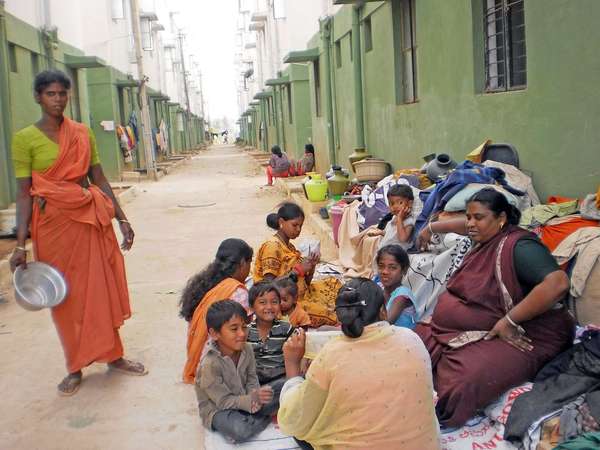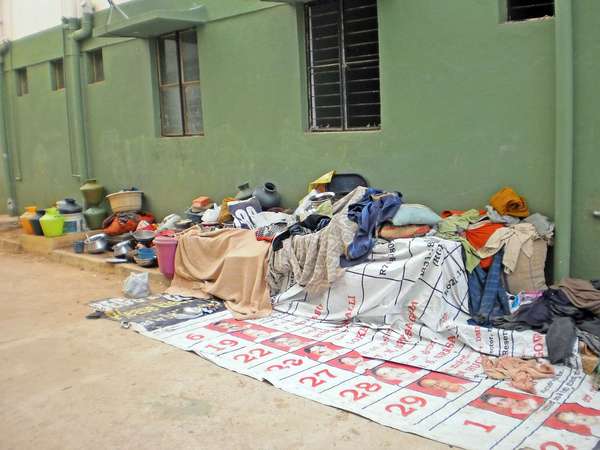When 900 families of Ejipura slum were thrown out last month, it was chaos for the families. While most have dispersed across the city, trying to find housing, about 55 families have moved into a Slum Board quarters in Kudlu, along Hosa Road (off Sarjapur Road). About 80 families (450-500 people) remain in the footpath near the Ejipura site as they could not afford alternate housing.

Many families stayed out for days initially, even though most flats in the complex were vacant. Pic: Navya P K
Most of those who are in the Kudlu quarters, reached here by accident. They claim that supporters of MLA N A Haris (in whose constituency Ejipura falls), had dropped them off here. "During demolition, they got us into a tempo with our belongings, promising to give accommodation. We were dropped here. We do not know why they did this, as this place is meant for others," says Pinto, an Ejipura evictee.
A few others from Ejipura came here later, on knowing about those who came first. There are about 200 Ejipura people here now. Some 5-6 families have managed to find houses for low rent nearby. About five families moved to another older Slum Board quarters nearby, which is already occupied, but had some houses on rent. For the remaining families, about 45 of them, finding flats in the Kudlu quarters is still an issue.

Kudlu quarters. Pic: Navya P K
The paradox is that majority of the flats here are vacant. Though this project was completed in 2011, Karnataka Slum Development Board (KSDB) is yet to allot most flats.
The quarters has 1076 flats, and only 208 have been allotted so far. The current state of the quarters does not inspire much faith in Slum Board’s rehabilitation programmes – allotments have lagged, basic facilities have been lacking, and it is said that flats are sold illegally. The quarters was built under JNNURM.
The flats here are spread across two complexes. One complex, with 544 flats, is for those displaced from different slums across the city. It is in this complex that Ejipura evictees are living now. H M Shashidhar, AEE at the Board in charge of the project, says that construction started here in 2009, and that allottees started staying from 2011.

A flat in the Kudlu quarters, where an Ejipura family has moved in. Pic: Navya P K
The 208 families staying here, include those displaced from Arasu Colony in Gandinagar (107 families), Geddalahalli near Sanjay Nagar (73), and 28 families displaced from the Board’s former quarters which was in one part of the Kudlu site itself. That quarters was demolished and the land given to BWSSB to build a reservoir. Except the 73 families from Geddalahalli who came here six months back, others have been staying in the new complex since 2011, for about 1.5 years.
The Board is still preparing the list of people for whom the remaining 336 flats here will be given. Shashidhar says that this list was approved in a Board meeting couple of months back, and that the final list will be available in a week.
Though people have started staying here from 2011, much of the infrastructure works were not completed at the time – electrification, laying of main sewer lines etc were not done.
- 1076 Total flats in Kudlu quarters
- 208 flats allotted earlier (plus 512 being done now)
- 55 Ejipura families landed here
- 5 staying in nearby quarters
- 5 found houses nearby
- 39 staying in some flat they found on rent or just moved in
- 6 Ejipura families yet to find flats
Water supply is also an issue – there are 2-3 common taps now from which everyone is drawing water. Officers say that individual supply lines have been laid, but water is not coming in pipes since ground water level is very low in this area. They say that there have been cases of thefts, and of anti-social elements misusing and damaging the vacant flats, breaking windows etc.
Executive Engineer N P Balaraj says that many original allottees are not staying here because of the incomplete works. He says that works will be completed soon, and allottees are expected to start staying here.
So, only a few flats have been allotted so far. And even many of those allottees are not staying here because of poor facilities. For Ejipura evictees, situation here eerily parallels what happened in Ejipura EWS quarters years back.
On February 12th, some 60-70 residents of a slum in Laggere protested at the Slum Board’s office in Risaldar Street, off Palace Road. M D Narayan, state President of Dalitha Samrajaya Sthapana Samithi (DSSS), who was leading the protest, said that about 500 families had been living in the site for 30-40 years. "Now Slum Board has built a quarters here and allotted it to those from other slums." The defiant protesters had come with vegetables, pots and pans, and prepared lunch in the office premises itself, while officers looked on. An officer said that such protests were routine here.
There too, original allottees had moved out because of poor construction quality and facilities. Ejipura quarters case was appalling in that part of the quarters collapsed in 2003, within 12 years of construction. The quarters was built by BBMP, not Slum Board. Finally tin sheds were set up in the site. Many original allottees gave the tin sheds on rent to those who were looking for houses, and went elsewhere. Those who were staying on rent got evicted unceremoniously, last month.
Many Ejipura evictees had decided not to come to Kudlu quarters because they feared that they would be evicted from here too.
It is also said that some agents are trying to sell off some flats, colluding with Slum Board officers.
Haseena, who is middle-aged and lives with her husband and three children, had come here from Ejipura. She stayed outside the quarters for days with all her belongings, waiting for an original allottee from whom she can rent a flat. Though she contacted many of them over the phone, they did not rent out the flats fearing that it was illegal. Allottees are not supposed to transfer the flats to anyone else.
But a resident in the quarters gave Haseena the contact of an agent. Haseena says that he was ready to sell the house to her if she paid Rs 2 lakh right away. Haseena could not afford this. "If I had such money, wouldn’t I have found a house elsewhere for rent?" says Haseena.
Mohammad Sameer, an original allottee who has been staying here for around a year, says that this gang has been operating for long.

Slum Board’s representation of flats for Ejipura evictees being planned in Sulikunte. Many such G+4 buildings are to come up in a 5 acre land. Pic: KSDB
"They sell houses to better-off people, and give a cut to Slum Board officers. One of them asked me if I knew anyone who was looking for a house. Later they asked me to move out of my flat so that they could sell it, but I did not agree," he says. Sameer’s flat is in the ground floor, and is supposed to fetch better prices from buyers.
Balaraj says that he is unaware of agents selling off houses, and that there is no scope for this. Selling flats is illegal because these flats are only to rehabilitate those who live in declared slums. The Board does socio-economic surveys to find the details of residents in such slums, and lists them out in its website. Often people get houses many years after they pay the Board. Sameer says that he had paid the Board 12 years back, and had got the house only last year.
About ten families like that of Haseena stayed outside for many days initially. Slum Board officers later allowed them to stay in an empty community hall in the complex. Relief workers say that there are still six families there. The others are either renting flats from original owners, or are staying in empty flats after breaking the locks.
There are also con men who have been cheating them from the start. A student at Azim Premji University who has been doing relief work for the Ejipura evictees here, says on condition of anonymity, that it is difficult to identify original owners. "Some people claiming to be original allottees collect advances from Ejipura evictees and allow them to stay in flats. Later, original owners would come and throw them out of the flats," she says. For those who managed to actually rent houses, the advance is Rs 10,000-15,000, and monthly rent ranges from Rs 800-1600.
While this is condition of one complex in the Kudlu quarters, the second complex is reserved for 512 families who are soon going to be evicted from SDS Sanatorium slum. This slum is located in the premises of SDS Sanatorium hospital, and there is a court order to evict them and give them flats here.
Balaraj says that the residents there have been refusing to move out as the new site is too far from their workplaces. "They want in-situ development. We sent eviction notices to them six months back, but they did not move," says Balaraj. Currently, allotment letters are being issued to them. If they do not move out within one week of getting the letters, they will be forcefully evicted.
Slum Board’s plan for Ejipura evictees
The Board has got sanction for developing 900 flats for Ejipura evictees in a 5-acre site in survey number 122 of Sulikunte village, off Sarjapur Road. The site is about 16 kms away from the Ejipura site, and is currently vacant. The flat will be set up in G+4 buildings. Total project cost is Rs 57 crores, including that of common facilities.
The project comes under Rajiv Awas Yojana (RAY) of the central government. Under this scheme, central government will spend 50% of the cost, state 40% and the beneficiaries themselves will contribute 10%.
Ravikumar, Deputy Chief Engineer at the Board says that it is not clear if BBMP will fund this 10%, or if the evictees will have to shell out the amount themselves. The cost of an individual flat will be about Rs 4.5-5 lakhs, which means evictees will have to pay Rs 45,000-50,000 for a flat. At the time of Ejipura eviction, BBMP had promised that it will fund the 10% cost, but Slum Board has not got any formal assurance from BBMP on this.
The project’s DPR (Detailed Project Report) summary shows that each flat will have carpet area of 25 sq m (about 269 sq ft). There will be a hall, one bedroom, kitchen, bathroom and toilet in each flat. The plan shows provision for water supply, sewage system, roads, street lights, a community centre, livelihood centre and an informal market in the complex.
The tender process is yet to start. The project is supposed to be completed within 1.5 years of awarding the tender.
Ravikumar says that majority of the 900 evictees have already collected their biometric cards. The Board has the full list, and hence those who have not collected the cards yet can collect it later, he said.
With the Board’s track record, one can only hope that the Ejipura evictees get their due.⊕